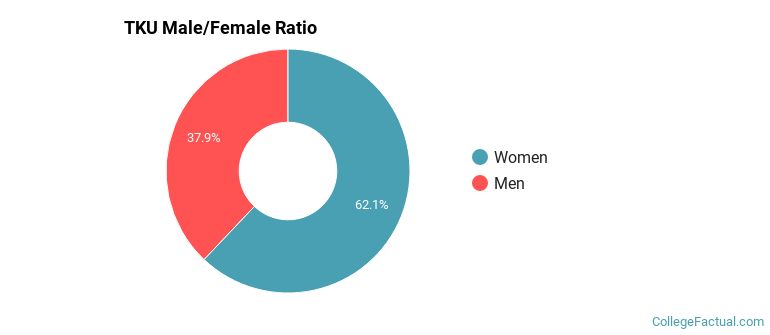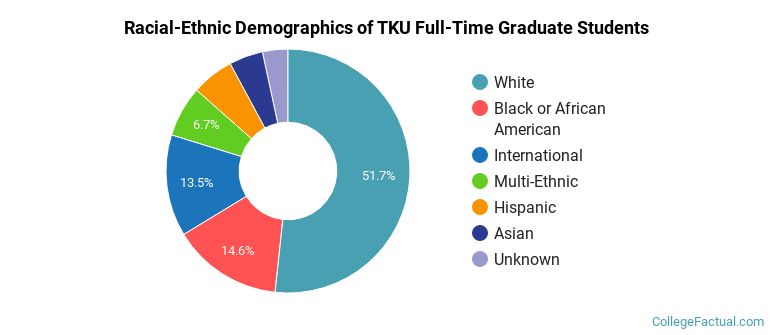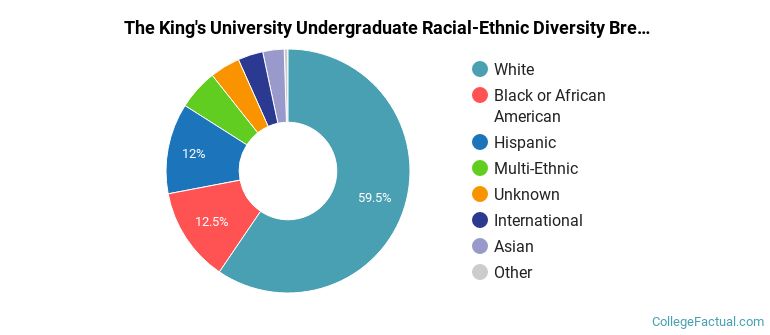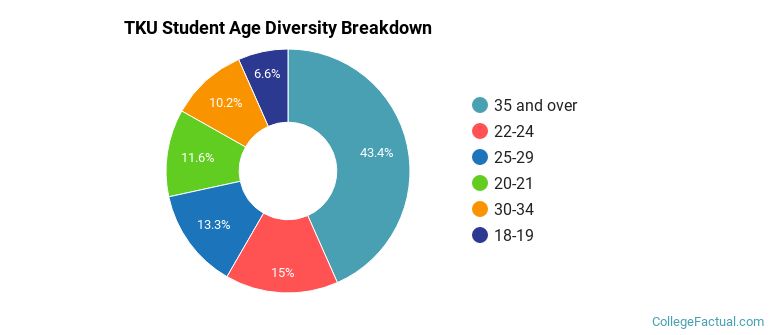 by our College Data Analytics Team
by our College Data Analytics TeamTKU total enrollment is approximately 666 students. 163 are undergraduates and 135 are graduate students.
Male/Female Breakdown of Undergraduates
The full-time TKU undergraduate population is made up of 66% women, and 34% men.

For the gender breakdown for all students, go here.
TKU Racial/Ethnic Breakdown of Undergraduates

| Race/Ethnicity | Number |
|---|---|
| White | 107 |
| Hispanic | 27 |
| Multi-Ethnic | 10 |
| Unknown | 7 |
| Black or African American | 4 |
| Asian | 3 |
| International | 2 |
| Native Hawaiian or Pacific Islander | 0 |
See racial/ethnic breakdown for all students.
Male/Female Breakdown of Graduate Students
About 55% of full-time grad students are women, and 45% men.

For the gender breakdown for all students, go here.
TKU Racial-Ethnic Breakdown of Graduate Students

| Race/Ethnicity | Number |
|---|---|
| White | 70 |
| Black or African American | 24 |
| International | 11 |
| Hispanic | 8 |
| Asian | 7 |
| Multi-Ethnic | 7 |
| Unknown | 7 |
| Native Hawaiian or Pacific Islander | 0 |
See racial/ethnic breakdown for all students.

| Race/Ethnicity | Number |
|---|---|
| White | 393 |
| Black or African American | 83 |
| Hispanic | 73 |
| Multi-Ethnic | 35 |
| Unknown | 32 |
| International | 20 |
| Asian | 18 |
| Native Hawaiian or Pacific Islander | 2 |

There are approximately 372 female students and 294 male students at TKU.
TKU ranks 1,273 out of 2,183 when it comes to geographic diversity.
20.69% of TKU students come from out of state, and 0% come from out of the country.

The undergraduate student body is split among 6 states (may include Washington D.C.). Click on the map for more detail.

| State | Amount |
|---|---|
| Texas | 23 |
| New York | 2 |
| Colorado | 1 |
| Illinois | 1 |
| Kansas | 1 |
Students from 15 countries are represented at this school, with the majority of the international students coming from Brazil, Netherlands, and Bermuda.
Learn more about international students at TKU.
A traditional college student is defined as being between the ages of 18-21. At TKU, 17.82% of students fall into that category, compared to the national average of 60%.

| Student Age Group | Amount |
|---|---|
| 35 and over | 281 |
| 22-24 | 97 |
| 25-29 | 86 |
| 20-21 | 75 |
| 30-34 | 66 |
| 18-19 | 43 |
| Under 18 | 0 |
Footnotes
*The racial-ethnic minorities count is calculated by taking the total number of students and subtracting white students, international students, and students whose race/ethnicity was unknown. This number is then divided by the total number of students at the school to obtain the racial-ethnic minorities percentage.
References
Department of Homeland Security Citizenship and Immigration Services
Learn more about how College Factual creates their Diversity Rankings.